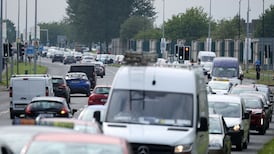Seán Mac Connellbelieves he has every right to his place aboard the Flight of the Earls commemorative voyage. He explains why.
'You are a bastard, bred from bastards. You are from the wrong side of the O'Donnell clan, bar sinister, Mac Conáil," my history teacher informed me and all my classmates one September evening more than four decades ago.
I can still remember the stillness in the classroom and then the titters of laughter from the other kids as the teacher, now long dead, flung my exercise copy at my blushing 14-year-old face.
That was a traumatic piece of information for a youngster to absorb, but perhaps, because of my ill-breeding, I went on to bear the badge Fr Peadar Livingstone had imposed on me all those years ago with a certain pride.
To be a descendant of Red Hugh O'Donnell was no great burden to bear in south Fermanagh, the land of the Maguires, who had hired the boat on which the Earls had fled Ireland in September 1607.
A fortnight ago in The Irish Times, Donegal County Council, which has been running a very successful series of commemorative events, offered the trip of a lifetime to those who wanted to sail from Rathmullen to France to commemorate the event of 400 years ago.
I decided it was time to claim my "berthright". Such an occasion would certainly be able to accommodate someone with at least some royal blood, even if he is "bar sinister", the heraldic symbol on a coat of arms which indicates illegitimacy if it runs from top right to bottom left.
Researching papers for the voyage, it came as little surprise to me then when I found a list drawn up by an English spy who had conveyed to Dublin Castle the names of "The Fugitives with the Earls of Tyrone and Tyrconnell". There were 37 names in total.
They were named as the Earl of Tyrone, the Earl of Tyrconnell, the Baron of Dungannon, Caffer O'Donnell, his brother The McGuire, Shane Groom, his steward, Fr Florence the friar, Capt John O'Connor, Cormac O'Neill's son, Donnagh O Brien, and then, "Ever McConnell's two sons".
There were the ancestors in black and white in the Calendar of State Papers, Ireland, 1606-8, listed above the wives, lackeys and serving men, children and friars.
Fr Livingstone had not presumed, he was right all along.
There were 99 people on board that ship which left Rathmullan 400 years ago. They were an elite who controlled what was then Gaelic Ireland, with its own code of laws and way of life, which was being squeezed from south and east following the disastrous defeat of the Northern armies at Kinsale in 1601.
The two Hughs, O'Neill and O'Donnell, had virtually cleared the country of English forces during the Nine Years War running up to 1601, but it was O'Donnell's impatience which lost them the decisive battle at Kinsale, though others say it was the bad beef fed to the Ulstermen, who normally dined on pigmeat.
Following the defeat of the Irish, Red Hugh O'Donnell went to Spain, where he died in 1602, probably poisoned by a double agent, Capt James Blake of Galway.
O'Neill fled back North after Kinsale and eventually surrendered to the English lord deputy, Mountjoy, at Mellifont Abbey in 1603, something he would not have done had he known that Queen Elizabeth I had just died.
No one is quite sure why he eventually took flight for Spain in September 1607, but his position in Ulster was weakened enough for the Mac Suibhnes to attack his party before it set sail.
A Capt John Rath was master of the French ship which had been arranged by the Maguires that took the party of 99 away from Rathmullan and into ferocious storms as they made their way down the Atlantic coast, all the time avoiding British ships.
Thirteen days and many storms later, the vessel made it as far as the mouth of the Seine at Quilleboeuf, when, according to a contemporary account, there was "only one barrel of fresh water and five gallons of beer available to the ship's company".
THE BAD NEWS for those of us leaving on the tide from Rathmullan on Monday is that the Jeanie Johnston, which has been chartered to recreate the event, is a "dry" ship which forbids the consumption of alcohol aboard.
The captain is also insisting that the 20 or so passengers who will be travelling do their four-hour watches and help set the sails and clean the boat. I suspect that The O'Donnell or The O'Neill would have had none of that.
There is, however, a mention, in the description of the voyage written by Tadhg Ó Cianáin, that O'Neill did help at one stage when he trailed a relic of the True Cross on a gold chain behind the ship to calm the storm, which it did.
As the hour approaches for our voyage, I suppose it is leaving it a bit late to look for a relic of the True Cross or a gold chain, for that matter.
It also appears that the departure from Rathmullan on Monday will be a bit less ferocious than it was 400 years ago, even though there are likely to be Mac Suibhnes and a few other traditional enemies of the O'Donnells and O'Neills in the farewell party which has been arranged.
My travelling companions, I am told, are a diverse bunch from across the globe, and over the week-long voyage I hope to tell you about them and why they are aboard, following in the steps of the Earls.
Séan Mac Connell will report daily from the Jeanie Johnston in next week's Irish Times.








